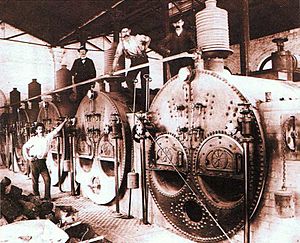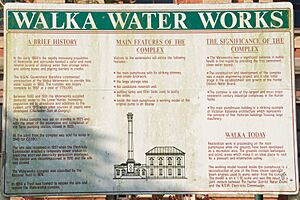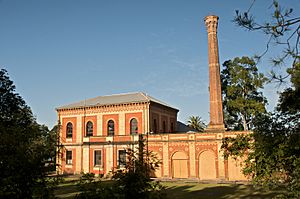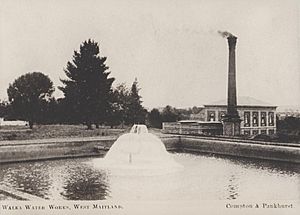Walka Water Works facts for kids
Quick facts for kids Walka Water Works |
|
|---|---|
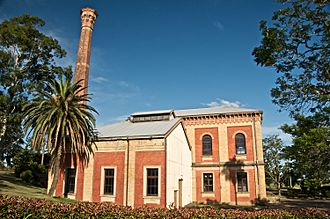
The pump house and smoke stack
|
|
| General information | |
| Architectural style | Victorian Italianate |
| Location | Oakhampton Heights |
| Address | 55 Scobies Lane, Oakhampton Heights, City of Maitland, New South Wales, Australia |
| Town or city | Maitland, New South Wales |
| Country | Australia |
| Coordinates | 32°42′49″S 151°33′13″E / 32.71367°S 151.55351°E |
| Construction started | 1882 |
| Completed | 1887 |
| Cost | £170,000 |
| Client | Government of New South Wales |
| Technical details | |
| Structural system | Brick |
Walka Water Works is a special old pumping station in Oakhampton Heights, New South Wales, Australia. It was built way back in 1887. Its main job was to provide clean water to the cities of Newcastle and the lower Hunter Valley.
Today, Walka Water Works has been fixed up and protected. It is now part of the Walka Recreation and Wildlife Reserve. This means it's a fun place for families to visit! It was added to the New South Wales State Heritage Register on 2 April 1999 because it's an important historical site.
Contents
History of Walka Water Works
Why Was Walka Water Works Built?
In 1875, people in Newcastle needed a better way to get water. There had been a very dry period, and water was scarce. So, the local council formed a committee to find a solution.
In 1876, a local politician named George Lloyd asked the government for help. He wanted money to build a water supply system for Newcastle. Many other politicians agreed with him.
In 1877, a famous engineer from Britain, William Clark, came to New South Wales. He was asked to find good water sources for towns in the Lower Hunter region. Clark suggested that Walka would be the perfect place for a water works. He estimated it would cost about £170,000 to supply water to 37,000 people.
The people of Newcastle liked this plan and its cost. They quickly approved it. They even sent a group to the Parliament to push for the project.
Building the Water Works
Even with all the support, building the water works took time. Different governments came and went, and sometimes other projects were given priority. But by May 1879, plans were ready enough to order machines and pipes.
In 1881, the first parts of the project began. Reservoirs were built in Newcastle and Buttai. Land was also set aside for the Walka Water Works.
The Public Works Department asked companies to bid on building the Walka reservoir in December 1882. Contracts were signed in April 1883. Several companies worked on different parts of the project.
One company, Smith and Burley, built a tunnel to bring water from the river to the pumping station. George Blunt built the reservoir and filter beds. James Watt and Company from England supplied and set up the three pumping stations. James Russell finished building the engine and boiler house.
The whole design for Walka Water Works was created by Sir William Clark. It was a huge engineering project for its time! Water was pumped from the Hunter River through a brick tunnel. This tunnel was about 6 feet (1.8 metres) wide and 9 feet (2.7 metres) underground.
When it was fully working, the station had three powerful pumping engines. Each engine had a huge flywheel that weighed 36 tonnes! Water was pumped from the river to the Walka reservoir, which is now known as Walka Lake. From there, it was pumped to another reservoir 6 miles (9.7 kilometres) away at Buttai. Then, gravity helped the water flow to homes.
Growing Demand for Water
Walka Water Works was the only water supply for the Lower Hunter towns from 1887 until 1929. During this time, more industries developed and the population grew. This meant people needed more water.
In 1892, the pumps were made better. The Hunter District Water Supply and Sewerage Board took over the works that same year. By 1900, Newcastle was using twice as much water as it had in 1892!
Having a good water supply for drinking and washing also helped towns build sewerage systems. This made the community much healthier. It reduced diseases and made cities cleaner.
Challenges and Changes
There were severe droughts in 1902 and 1905-1906. These droughts showed that the Hunter River was not always enough to supply water for everyone. So, more filter beds were added in 1908. By 1910, all three pumping engines sometimes had to run at the same time.
More equipment was installed in 1913, and four more water filters were added in 1916. At its busiest in 1915, the water works produced 3,843 megalitres of water!
As the population kept growing, new water sources were found. One important new source was Chichester Dam near Dungog. From 1923 to 1940, Walka Water Works was only used as a backup water supply.
In 1925, the complex was put on standby. Then, during the Great Depression in 1931, it was completely shut down to save money. After World War II, in 1949, all the old machines were sold for scrap metal.
Walka as a Power Station
Two years later, in 1951, Walka Water Works got a new life! It was reopened as a temporary coal power station. This was done by the Electricity Commission to help with electricity shortages after the war.
A "package power plant" was bought from America and brought to the site. It started making electricity in 1953. Three boilers ran on coal, and one ran on oil. Later, the oil boiler could also use coal. Two railway lines were built to bring coal to the power station.
Using Walka as a power station had some problems. The foundations of the plant started sinking, and there were strikes by workers. Also, one of the oil storage tanks collapsed in strong winds. Local farmers complained about the soot (black dust) the station produced.
The power plant stopped making electricity in 1976 and was taken apart in 1978.
Walka Recreation and Wildlife Reserve
It wasn't until 1984 that people really tried to reopen the site. A group was formed to restore the Water Works complex. The National Trust had already recognized its importance in 1976.
Today, Walka Water Works is a free public park. It has areas for barbecues and picnics, a playground, and walking trails. There's even a miniature railway that offers rides on Sundays! The lake and plants make it a special home for many birds and animals.
What You Can See at Walka Water Works Today
The Walka Water Works site is shaped a bit like a diamond. It includes a hillside, slopes leading to a U-shaped lake (the old reservoir), and the old industrial buildings.
The main buildings are made of strong brick. They have large roofs made of corrugated iron.
Main Pump House
This is a two-story building made of different colored bricks. Its walls are very thick, up to 1 meter! It has a basement that is about 10 meters deep. You can still see six large cast iron columns that supported the first floor.
Boiler Room
This room is attached to the main pump house. It has a double-hipped roof made of corrugated iron. You can still see where the steam pipes were and some interesting windows.
Chimney
The tall chimney is made of different colored bricks and stands 36 meters high. It starts with a square base, then becomes eight-sided, and finally a round, tapering cylinder.
Western Pumphouse
This part was built in 1913. It was designed to match the original building. The roof has exposed steel trusses. The southern wall was built of timber and corrugated iron so that the building could be easily expanded later.
Workshop
This is a small building north of the boiler room. It has four cast iron chutes in its northern wall. This wall is a retaining wall built against a hill.
Settling Tank
This is a large rectangular tank (220 feet by 115 feet by 10 feet). Its walls are made of brick covered with cement. The floor is concrete. This tank was used to let dirt settle out of the water.
Filter Beds
There are seven filter beds that were built in three stages. These beds used layers of sand, gravel, and brick to clean the water. Some of them are still mostly intact.
Clearwater Tank
This brick tank is located below the filter beds. It was where the clean water was stored after filtration.
Reservoir (Walka Lake)
The edges of the reservoir follow the natural shape of the land. The inside is lined with sandstone blocks. A brick channel with a large valve could be opened to lower or drain the water in the reservoir.
Old Homes for Engineers
You can still see the foundations of the homes where the Chief Engineer and the Second Engineer used to live.
Nature at Walka Water Works
Walka Water Works is home to a special type of forest called Lower Hunter Spotted Gum-Ironbark Forest. This forest has survived because the area around the lake has been protected for a long time.
This area is a great place for birds and animals. Over 300 different kinds of birds have been seen here! Four rare bird species have been recorded: the Australasian bittern, black bittern, blue-billed duck, and freckled duck.
Other Features
You can also see old concrete roads and paths that were put in by the Electricity Commission in the 1950s. There are also some old trees from the original water works time.
A railway line used to run from the power station along the lake. Some parts of the railway track are still there. You can also see parts of the old pipe networks.
Why Walka Water Works is Important
Walka Water Works is one of the biggest and most complete old industrial sites in the Hunter Valley. The water treatment parts that are still there show how water was cleaned and delivered in the late 1800s and early 1900s.
The pump house, chimney, and boiler house are beautiful brick buildings. They are located in a lovely landscape. The whole complex, including the lake and tanks, is an important cultural landmark.
Walka Water Works was added to the New South Wales State Heritage Register on 2 April 1999 because:
- It was a major achievement to build it. It gave clean water to Newcastle for the first time.
- The changes at the complex show how much the demand for water grew over time.
- It was a key part of the growth of the Hunter Valley Waterboard.
- The site's history as both a water plant and a power station shows important changes in the community.
- Famous engineers like William Clark were involved in its design.
The site is also important because:
- It's still very beautiful and hasn't been spoiled by new buildings.
- The brick buildings, filter beds, tanks, and lake create a special and beautiful place.
Walka Water Works has a strong connection to the community:
- It helps us understand how industrial processes worked in the 1800s.
- It was a huge step forward for public health in the Hunter Valley. It made people healthier and cities cleaner.
- Without this water supply, many industries in Newcastle could not have started.
The site can also teach us a lot:
- It's the only complete set of 19th-century water filtration equipment left in New South Wales. It clearly shows how water was treated.
- You can see how steam technology changed over time.
Because the site is so well preserved, it's an excellent example of how water was filtered and delivered during that period.
Engineering Heritage Award
The Walka water supply system received a special award called an Engineering Heritage National Marker from Engineers Australia. This award recognizes its importance in engineering history.


